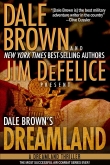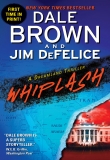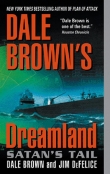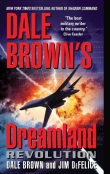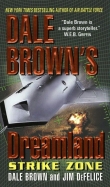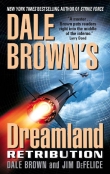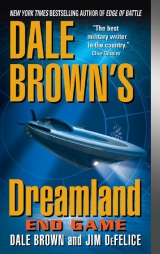
Текст книги "End Game"
Автор книги: Dale Brown
Жанр:
Боевики
сообщить о нарушении
Текущая страница: 2 (всего у книги 22 страниц)
Worse, Breanna had made Stewart her copilot.
Bad enough to fly what was still essentially a B-52 after the hotter-than-fire B-1B. Worse—much, much worse—to be second officer after running the show.
Today, though, Stewart was boss. Her nemesis had been scrubbed at the last minute due to a snowstorm in Chicago.
“EEMWB detonation in twenty seconds,” said Lieutenant Sergio “Jazz” Jackson, who was serving as her copilot.
“Yup.”
A tone sounded in her headphones, indicating that the weapon had detonated. Stewart hot-keyed her communications unit to tell the event commander, but got no response.
She pulled back on the stick slightly, but the airplane failed to move.
Had the shielding failed?
Only partially—her configurable control panel was still lit.
She’d go to manual control right away.
22
DALE BROWN’S DREAMLAND
Interphone working?
“Prepare for manual control,” she said.
“Manual?” said Jazz.
Immediately, Stewart realized what had happened—she’d turned the aircraft over to the flight control computer for the missile launch as part of the test protocol, and neglected to take it back.
It was a boneheaded mistake that would cost her at least two rounds of beers. Thank God the Iron Bitch hadn’t been here to see it.
“I mean, taking over control from the computer,” Stewart told Jazz lamely.
“That’s what I thought,” said the copilot.
“Dreamland Levitow,” said the event controller. “Please repeat your transmission. I’m sorry—we were caught up in something here.”
I’ll bet, thought Stewart, not entirely convinced that Breanna hadn’t somehow conspired with them to make her look bad.
DR. RAY RUBEO, DREAMLAND’S HEAD SCIENTIST, WAS WAITing for Colonel Bastian as he unfolded himself from the Raptor’s cockpit.
“So how’d we do, Doc?” Dog asked, coming down the ladder. Techies were already swarming over the Raptor, preparing it for a complete overhaul. Besides thoroughly analyzing the shielding and systems for signs of damage from the T-Rays, the engineering team was planning a number of improvements to the plane, including a new wing structure that would lower its unfueled weight by five percent.
“It’s premature to speculate,” said Rubeo.
“Do it anyway.”
Rubeo frowned. “I’m sure that when the results are analyzed, the models predicting the impact of the weapon will be shown to be quite correct. All of the test instruments reported full hits. And,” he paused dramatically, “one of the END GAME
23
ground technicians forgot to remove his watch, and now finds that it no longer functions.”
Dog laughed. The scientist touched his earring—a habit, the colonel knew, that meant he was planning to say something he considered unpleasant. Dog decided to head him off at the pass.
“Ray, if the full-sized weapons won’t be ready for testing—”
“Bah. They’re sitting in the bunker, all eight of them.
Though the tests are unnecessary.”
Then obviously I’m about to get harangued for more money, thought Dog, starting toward the Jimmy SUV waiting to take him over to the hangar area where he could change. Sure enough, Rubeo fell in alongside him and made the pitch.
“If you are going to proceed with the project, Colonel, I need several more technicians to assist while the team is away.”
“Can’t do it, Ray. You’ve seen the budget.”
“Colonel, we are past squeezing water from a stone. We need more people.”
Dog stopped to watch Dreamland Levitow practicing touch and goes on the nearby runway. As part of a new policy at Dreamland, the EB-52 Megafortress had been named for Sergeant John L. Levitow, an Air Force Medal of Honor winner. A crewman in an AC-47 gunship during the Viet-nam War, Sergeant Levitow had thrown himself on a live flare inside the hold of his damaged aircraft following a mortar hit. Despite numerous wounds, he managed to toss the flare outside of the aircraft before it ignited, saving the entire plane.
Rubeo renewed his pitch as the plane passed overhead.
“Colonel—we need more people.”
“If the EEMWB project gets funding, we’ll have more slots.”
“Only if it’s approved as part of the Anti-Ballistic Missile Program, which it shouldn’t be.”
24
DALE BROWN’S DREAMLAND
Rubeo had made this point before: The EEMWB was not a good ABM weapon, since the lead in technology would last, by his estimate, no longer than five years. And it was not selective—everything in the area was disabled, not just the target. Dog didn’t disagree, but he didn’t see that as an argument against proceeding with the weapon, which would provide a decent solution until other technologies matured. And he especially thought this was a good idea since it would help him get the people Rubeo needed.
“We have to be practical,” said Dog.
“Colonel, I’m the most practical scientist I know.”
“That isn’t saying much, Ray,” Dog told him, climbing into the truck.
Near Port Somalia
5 January 1998
2304
CAPTAIN SATTARI FELT THE SLIGHT BURN AT THE TOP OF HIS
shoulders as he paddled in unison with the others, propelling the small boat toward their target. The wind came at them from the west, trying to push them off course. They compensated for it as they stroked, but the boat still drew a jagged line forward.
Sattari allowed himself a glance to the other three craft, gauging his performance; it seemed to him that their boat was doing better than two of the others, and not much worse than Sergeant Ibn’s, which was in the lead.
The raft lurched with a sudden swell. Sattari gripped his oar firmly and dug at the water, stroking hard and smooth.
His instructor had claimed propelling a boat was a matter of finesse, not strength, but the man had rowed every day of his life for years, and surely took strength for granted. Sattari’s chest rose and fell with the roll of his shoulders, as if he were part of a large machine. He heard the hard, short breaths of the men around him, and tried to match them.
END GAME
25
A light blinked ahead. Ibn’s boat had stopped a few meters away. They changed their paddling and surged next to the other raft with a well-practiced flare. First test passed, thought Sattari. He reached for his night glasses and scanned around them as the other boats drew up.
Sergeant Ibn moved in the other raft until he was alongside his commander.
“No sign of the Indian warship,” said Ibn.
“No. Nor the helicopter.”
A helicopter had nearly run into one of the airplanes roughly seventy miles from shore. Captain Sattari was not sure where it had come from. It seemed too far from Port Somali to belong to the small Indian force there, nor had the spies reported one. The Somalian air force had no aircraft this far north, and it seemed unlikely that it had come from Yemen.
“The helicopter most likely belonged to a smuggler,”
said Ibn.
“Perhaps,” said Captain Sattari. “In any event, let us proceed.”
“God is great.”
Sattari put his glasses back in their pouch and began helping the four men on his boat who would descend to the pipes below them to plant their explosive charges. The charges they carried were slightly bigger than a large suitcase, and each team had to place two on the thick pipes below.
Sattari positioned his knee against the side of the raft, but cautioned himself against hoping it would brace him; he’d already seen in their drills that the raft would easily capsize.
The trick was to use only one hand to help the others balance their loads; this was a heavy strain, but the team he was assisting managed to slip into the water without a splash or upsetting the raft.
The men on the raft on the other side of him did not. The little boat capsized.
Sattari picked up his paddle, as did the other man on his raft. They turned forty-five degrees, positioning themselves 26
DALE BROWN’S DREAMLAND
to help if necessary. But the two men on the other boat recovered quickly; within seconds they had their vessel righted and were back aboard.
“Good work,” Sattari told them.
He turned back toward Ibn’s raft. The sergeant had gone below with the others, but one of the two men still aboard had a radio scanner, which he was using to monitor local broadcasts. As Sattari picked up his oar to get closer, the coxswain did the same. They pushed over silently.
“Anything, Corporal?” Sattari asked the radioman.
“All quiet, Captain.”
“There was nothing from the Indian warship?”
“No, sir. Not a peep.”
Sattari scanned the artificial island, roughly two miles away. Aside from a few dim warning lights on the seaward side, it was completely in shadow. It slumbered, unsuspecting.
“We will proceed,” Sattari said. “God is great.”
Aboard the Abner Read , off the coast of Somalia
2340
STORM TOOK ADMIRAL JOHNSON’S COMMUNICATION IN HIS
cabin. The admiral’s blotchy face was rendered even redder by the LCD screen. Johnson was aboard his flagship, the Nimitz, sailing in the waters north of Taiwan.
“What’s going on out there, Storm?”
“Good evening, Admiral. I’m about to send a boarding party over to a boat I suspect is a smuggler.”
“That’s what you called me about?”
“No,” said Storm. “About an hour ago we spotted four aircraft flying very low and fast toward northeastern Somalia. We were not able to identify the aircraft. Given the size of the force, they may have been terrorists going ashore to a END GAME
27
camp we don’t know about. Since they were flying in the direction of Port Somalia, I tried to contact the Indian force there, but could not. I wanted to send—”
“Port Somalia? The Indian tanker station? What is your exact location?”
“We’re about eighty nautical miles—”
“Exact location.”
Storm looked over to the small computer screen near the video display, then read off the GPS coordinates.
“What are you doing so close to that end of the gulf?”
said Johnson. “You’re supposed to be chasing pirates.”
“With all due respect, Admiral, that’s what I’m doing. I have a smuggler in sight, and we’re preparing to board her.
I called to alert you to these aircraft, so a message could be sent through the normal channels. I don’t know whether their radio—”
“You know as well as I do that you’re a good deal east of the area we discussed two days ago. A good deal east.”
“I’m within the parameters of my patrol area. I’m not in coastal waters.”
When Johnson was displeased—as he was just about every time Storm talked to him—his cheeks puffed slightly and his eyes narrowed at the corners, so that he looked like the mask of an Asian sea devil. When he became really angry—which happened often—his forehead grew red and he had difficulty speaking. Storm saw the space above his eyebrows tint, and decided it was time to return the conversation to its point.
“Should I attempt to contact the Pentagon to alert the Indians at Port Somalia?” he asked.
“No, you should not.” Johnson scowled. “We’ll handle that here.”
The screen blanked before Storm could respond.
28
DALE BROWN’S DREAMLAND
Off the coast of Somalia
2345
CAPTAIN SATTARI FELT HIS GLOVED HAND SLIPPING FROM THE
rope. Swinging his left arm forward, he managed to grab hold of the cross-hatched metal fencing at the side of the support pillar. For a moment he hung in midair five meters over the water and rocks, his fate suspended.
If I slip, he thought, the man behind me will fall as well.
He will be killed, and even if I survive, I will never be able to draw a breath as a man again.
He’d practiced this climb for months. He could do it. He had to do it.
With a ferocious heave, Sattari pulled himself to the pillar. Hanging by three fingers, he hunted for a better handhold. His left arm seemed to pull out of its socket before his right hand found a grip.
Up, he told himself, forcing open the fingers on his left hand. Sattari jerked his arm upward, throwing it against the fencing. His right arm had always been stronger than his left; he found a good hold and rested for a moment, then attacked the fence again, trying but failing to get a toehold so he could climb rather than pull. Again and again he forced his fingers to unclench; again and again he felt his shoulders wrenching. Even his right began to give way before he reached the top.
The first man up stood by the rail, waiting. Sattari took the rope he had carried up, tied it to the rail, then tossed it down. The captain helped the man who had started up behind over the rail, then went ahead.
Their target was a pipe assembly and tank housing fuel for the boats that docked here. Besides the large tanks containing ship fuel, there were two tanks that held the lighter—and more flammable—marine fuel used by small vessels. The tanks and some of the associated machinery sat behind a Cyclone fence topped with barbed wire. The point man began cutting a hole through the fence with a set END GAME
29
of large wire cutters; Sattari went around the decking to the corner to act as a lookout while the others prepared to set explosives on the tanks.
A pair of metal staircases led down to the lower docking area just beyond the turn where he took his position. A small boat was tied to the fiberglass planks, and he could hear it slapping against the side with the current.
Sattari could also hear his heart, pounding in his chest.
Never had he been this nervous, not even on his first solo flight.
The Indians had roughly two dozen men permanently on the island; another three or four dozen workers came out during the day when ships were docked or to finish up the many small items that still had to be perfected before the official opening in a few weeks. At night, a force of no more than eight men were on duty, manning lookouts on the northern and eastern sides of the large complex.
A local spy had reported that the watchmen varied their patrols admirably, making it impossible to time their rounds. However, this area was consistently neglected; like many security forces, the guards concentrated their efforts on what they thought the biggest prize was.
Sattari heard a noise behind him. He turned; the man who had cut the hole in the fence raised his hand in the air.
The charges had been set.
They retreated to the ropes. Remembering the trouble he’d had climbing with the gloves, Sattari pulled them off.
Better to burn his hands, he thought, than to lose his grip.
He slung his gun over his shoulder and took hold of the rope, waiting for the point man before starting.
Sattari was about a third of the way down when his companion said something. The words were garbled in the wind; as Sattari glanced toward him to ask what he’d said, a gun barked from above.
Without consciously thinking about what he was doing, Sattari hooked his foot taut against the rope and swung up his gun. A muzzle flashed above him; he pushed the AK-47
30
DALE BROWN’S DREAMLAND
toward the burst of light and fired. His bullets rattled sharply against the steel superstructure. Thrown off-kilter by the kick of the gun, the captain swung to his right and bounced against the fence. Before he could grab on and stabilize himself, he saw two shadows moving above and fired again. This time one went down, though whether because he was ducking or had been hit was impossible to say. The other shadow returned fire. Sattari squeezed the trigger of the AK-47 once, twice, several times, until its magazine was empty.
He let the rifle drop against its strap and skidded down the rope. The captain hit the water and bounced backward, rolling against a rock, half in, half out of the sea. Pushing forward, he willed himself in the direction of a boat floating nearby. Gunfire erupted from above. As he was about to dive into the water, he saw a shadow behind him on the rocks; it had to be one of his men. He twisted back, half hopping, half crawling, aiming to grab the man and drag him into the sea and safety. Bullets danced around him, but Sattari focused only on the black shadow that lay in front of him. He grabbed the man and pulled, growling as he did, a threatened bear cornered in an ambush. Pulling the soldier over his shoulder, he went back to the water, growling the whole time.
The steamy hiss of a rocket-launched grenade creased the air; a long, deep rattle followed. The water surged around him, pushing him down, but Sattari kept moving until hands reached out and grabbed him. The commando was lifted from his back, and Sattari was pulled into the raft. He pushed himself upright, looking around. They were the last boat to get away.
“Detonate the charges,” he told the coxswain when he saw his face.
“Now, Captain?”
“Now.”
END GAME
31
Aboard the Abner Read , off the coast of Somalia
2345
STARSHIP STEADIED THE WEREWOLF A MILE IN FRONT OF THE
small boat’s bow. The Abner Read was now less than two miles away, but the warship sat so low in the water that even if the smugglers had infrared glasses they probably didn’t know it was there.
“Werewolf, we’re about to radio them to stop,” said Eyes.
“Go ahead and turn on the searchlight.”
“Roger that,” said Starship.
The halogen beam under the Werewolf’s nose caught the bow of the little boat dead on. Starship looked at the image from the Werewolf’s video feed; he saw shadows in the cabin but couldn’t make out much else.
A warning was broadcast in English, Arabic, and French on all of the maritime radio channels. Starship came over the craft and fired a “log”—an LUU-2 illumination flare—which lit up the boat and the sea around it. At the same time, a boarding party pushed off the Abner Read in a rigid-hulled inflatable boat.
Called a SITT, or shipboard integrated tactical team, the specially trained team of sailors was heavily armed and well-versed in dealing with smugglers. Starship’s job was to get a good look at the boat so the boarding party would know what to expect. He would train his weapons on the smuggler’s craft. The boat was so small it was likely the Hellfire missiles or even his 30mm cannon could sink it within seconds if he fired.
So could the Abner Read—its forward deck gun was already zeroed in.
“I have nobody on the forward deck,” Starship reported.
“Uh-oh, here we go—two guys coming out to the stern. Going to the boxes.”
“Are those weapons?”
32
DALE BROWN’S DREAMLAND
“Negative—looks like they’re trying to cut the crates loose. Want me to strafe them?”
“Unidentified ship has failed to acknowledge,” said Eyes, whose remarks were being recorded as evidence of the encounter. “Abner Read SITT team is en route. Werewolf, see if you can stop the smugglers from throwing the contraband overboard.”
“Roger that,” said Starship. He selected the aircraft’s 7.62 machine gun and sent a string of bullets into the rail of the small boat. He saw the people on the boat ducking as he flew past; wheeling the helicopter around, he steadied the nose to spray the stern again, using his weapon to keep them away from the back of the vessel.
A man emerged from the cabin. A second later the Werewolf’s flight control computer sounded a tone in his ear—the smuggler had fired a rocket-launched grenade at the small aircraft.
Starship jammed his throttle, ducking the grenade. Then he reached to the weapons panel, dialing up the Hellfire missiles.
“I have hostile fire,” he told Tac. “Permission to launch Hellfires?”
“Negative, negative,” said Eyes. “Don’t sink him.”
“I’m under fire,” Starship repeated. The men at the rear had gone back to the large crates.
“Do not sink that boat. We want the cargo intact.”
Stifling a curse, Starship keyed back to the light machine gun. As he nudged his stick forward, the man near the cabin picked up an automatic rifle and began firing. The tracers gave Starship something to zero in on as he pressed his own trigger. With the second burst, the man crumpled to the deck of the boat, sliding toward the low rail as it rocked in the water.
Starship returned his attention to the rear deck, where the two crewmen had succeeded in pulling one of the crates from its tie-downs and were shoving it over the side. As it went over, the entire boat began to tip as if it were going to END GAME
33
capsize. Starship continued northward and banked back around, dropping the small helicopter to ten feet over the waves. The men continued working on the crate. If he wanted the cargo, he would have to shoot them; warning shots would no longer do.
He got close enough to see the worried scowl on one of the men’s faces before he fired; the man fell limp on the deck as he passed over. Still, the other crewman refused to give up. He struggled with the chain that held the crate down as Starship zeroed in, finger dancing against the trigger. When the bullets caught him, they spun him in a macabre death dance, a large part of his skull flying off as if it had been a hat. The man danced off the side of the boat and disappeared.
“Defenses have been neutralized,” Starship said, taking the Werewolf back over the boat slowly. “I think the crew’s all dead. They got one of the crates over the side but I saved the other.”
“SITT is en route,” said Eyes.
A SPRAY OF WATER HIT STORM AS HE STEPPED OUT ONTO THE
flying bridge. The smuggler’s boat was two hundred yards away, off his starboard side; the SITT crew was aboard inspecting her. Storm’s communications gear could connect him instantly with the team as well as everyone on his own ship, and he had the crew’s frequency tuned in; he listened to the boarding party as it went about its work. The Werewolf hovered just over the bow of the little boat, its nose slowly moving back and forth as its pilot trained its weapons on the vessel.
“Captain Gale to SITT—Terry, you there?”
“Here, Captain.”
“What do you have?”
“RPGs. Crate’s filled with grenades and launchers. Have some heavy machine guns in the hold.”
“Get it all on video. Make sure we have a good record.
Then get back here and we’ll sink it.”
34
DALE BROWN’S DREAMLAND
“Aye aye, Captain.”
Storm went back inside. He was just about to see if he could hunt down a cup of coffee when Eyes’s excited voice erupted in his ear.
“Port Somalia has just been attacked!” shouted Eyes.
“There’s a fire on the artificial island, and the sonar array picked up the sound of a large explosion.”
Storm’s mind jumped from shock to reaction mode, sorting the information, formulating a response. The airplanes they’d seen before—they had to have been involved.
What would Admiral Johnson say now?
“Get Airforce down there right away,” said Storm. “Bring the SITT crew back, then sink the smuggler’s vessel, cargo and all. Prepare a course for Port Somalia,” he added, speaking to the navigational officer. “I’ll be in my quarters, updating Admiral Johnson.”
Off the coast of Somalia
6 January 1998
0023
THE COMMANDO SATTARI RESCUED HAD BROKEN HIS LEG
falling from the decking to the rocks, but had not been shot.
He slumped against the captain as the men paddled against the current. They attacked the waves like madmen, pushing against the spray, which seemed to increase with every stroke.
Sattari could hear the explosions behind them and saw the yellow shadows cast by a fire, but dared not take the time or strength to look back.
“Another kilometer,” yelled the coxswain. He was referring not to the rendezvous point but to the GPS position where the boat would turn to the north; the pickup would be roughly four kilometers beyond that.
Still, Sattari repeated the words aloud as a mantra as he END GAME
35
worked his paddle: “Another kilometer to go. One more kilometer to success.”
Aboard the Abner Read , off the coast of Somalia
0023
THE SMOKE FROM PORT SOMALIA ROSE LIKE AN OVERGROWN
cauliflower from the ocean, furling upward and outward. It was so thick Starship couldn’t see Port Somalia itself.
If the aircraft they’d seen earlier had deposited saboteurs—not a proven fact, but a very good guess—it was likely that the planes would be returning to pick up the men.
The Abner Read had activated its radar to look for them.
Starship’s job was twofold. First, scout the water and see if he could find any trace of the saboteurs. Second, check the nearby shore, which was the second most likely escape route. And he’d have to do all that in about ten minutes, or he’d risk running out of fuel before getting back to the ship.
He saw the Indian corvette to his right as he approached the outer edge of the smoke. The ship looked like an up-sized cabin cruiser, with a globelike radar dome at the top.
Designed for a Russian Bandstand surface targeting radar, the large dome held a less potent Indian design. But it was the small dish radar behind the dome that got Starship’s attention—the Korund antiaircraft unit extended its sticky fingers toward the Werewolf, marking a big red X on it for the ship’s SS-4 antiaircraft missiles.
“Werewolf One being targeted by Indian vessel,” Starship reported to Tac. He hit the fuzz buster and tucked the little helicopter toward the waves, weaving quickly to shake the radar’s grip. “Hey, tell these guys I’m on their side.”
“We’re working on it, Werewolf One. They’re having a little trouble identifying targets.”
“Duh. Tell them I’m not a target.”
36
DALE BROWN’S DREAMLAND
“We’re working it out. Stay out of their range.”
“It’s ten kilometers,” protested Starship.
“Head toward the shore and look for the raiding party.
We’ll let the Indians look at the water.”
“Yeah, roger that,” he said, jamming his throttle to max power.
Off the coast of Somalia
0028
THE LIGHT LOOKED LIKE THE BAREST PINPRICK IN A BLACK
curtain, yet everyone aboard the raft saw it instantly.
“There!” said the coxswain. He lifted a small signal light and began signaling.
“Go,” said Sattari, pushing his oar. “Stroke!”
The little raft heaved itself forward as the men pushed at the oar. Sattari felt the commando he had rescued stirring next to him.
“Rest,” he told the man. “We’re almost there.”
“Ship!” said the coxswain.
Sattari swept his head back, though he continued to row.
The low silhouette of the Indian patrol boat had appeared to the northeast; it was perhaps three kilometers away.
“Stroke,” insisted Sattari. The pinprick had grown to the size of a mayfly.
Sattari had personally told the commander of each of the four midget submarines to leave if threatened—even if that meant stranding the team he was assigned to retrieve. He did not regret the order, nor did he curse the Indian ship as it continued to move in the direction of the light. He only urged his men to row harder.
His own arms felt as if they were going to fall off. His head seemed to have tripled in weight, and his eyes ached.
“Two hundred meters!” called the coxswain.
A searchlight on the Indian ship, barely a kilometer away, swept the ocean.
END GAME
37
“Stroke!” yelled Sattari. “Stroke!”
And then they were there, clambering over the rail at the stern. The sleek conning toward the bow looked like the swept cabin of a speedboat, and the entire craft was not much longer than a runabout.
“Get aboard, get aboard,” said Sattari.
He pulled the raft close to him, then plunged his knife into its side. As it began to deflate, he saw the Indian patrol boat bearing down on them, its lights reaching out in the darkness.
One of the other commandos took the raft and began to pull it down into the hatch.
“No. Let it go. It will give them something to look at,”
said Sattari. He tossed it off the side, then pulled himself down the hatchway. The submarine’s crewman came down right behind him, securing the hatch.
“Commander, we are aboard. Dive,” Sattari said loudly, though the command was clearly unnecessary; he could feel the small vessel gliding forward, already sinking beneath the waves.
Aboard the Abner Read , off the coast of Somalia
0032
“THE INDIANS HAVE SPOTTED A COMMANDO BOAT ABOUT FIVE
kilometers from Port Somalia,” Eyes told Storm. “Empty.”
“Submarine?”
“Unsure. They don’t carry sonar. That’s a Russian Project 1234 boat. I’m surprised it made it across the Arabian Sea. I don’t envy their sailors.”
Storm studied the hologram. The Abner Read had a world-class passive sonar—the Littoral Towed Array System, or LITAS—which was carried on a submerged raft behind the ship. Built around a series of hydrophones, the system picked up and interpreted different sounds in the 38
DALE BROWN’S DREAMLAND
water. In theory, LITAS could hear anything within a twelve-mile radius of the ship, even in shallow waters where sounds were plentiful and easily altered by the sea floor. Very loud vessels—such as the Indian ship, which the system identified even though it was thirty-five miles off—could be heard much farther away.
The Abner Read also carried an active sonar developed by DARPA as part of a project known as Distant Thunder.
The sonar was designed to find very quiet electric submarines in what the engineers called “acoustically challenging” waters. The Abner Read had used it with great success to find a submarine operating on battery power in the canyonlike Somalian waters to the west. Like all active sonar, however, the device not only alerted the prey that it was being hunted, but told it where the hunter was, an important concession against a wily captain. Storm preferred to hold it in reserve if at all possible.
The northwestern tip of Somalia loomed about fifteen miles ahead. By altering course slightly, Storm could cut off the most likely escape route north and still be in a good position to chase a submarine if it headed west.
What to do when he caught it was a separate problem.
Admiral Johnson had not answered his message, and Storm needed his permission before engaging.
Given that Port Somalia was an Indian installation, the submarine might be Pakistani. They had exactly six subs—four French Daphne-class boats well past their prime, and two Augustas, modern boats that could sprint to about 20.5
knots while submerged, and could be extremely hard to find in coastal waters—worthy adversaries for the Abner Read.
Of course, if was a Pakistani boat, he wouldn’t be allowed to attack at all; the Paks were in theory allies.
The Iranians had Kilos, even more potent submarines, though they hadn’t moved from their ports in months.
“We’ll move closer to shore, close down the distance with the submarine, if there is one,” Storm told Eyes. He glanced at the hologram to see where the Werewolf was.
END GAME
39
“Have Airforce check the area where the raft was spotted, look for others.”

